Papers by Michael Bolognese

Circulation, Nov 26, 2013
Background: AMG 145, a fully human monoclonal antibody against PCSK9, was well tolerated and sign... more Background: AMG 145, a fully human monoclonal antibody against PCSK9, was well tolerated and significantly reduced low-density lipoprotein cholesterol (LDL-C) either as monotherapy or combined with other lipid-lowering agents in Phase 2 studies of 12 weeks’ duration. To date, longer-term safety and efficacy of AMG 145 in hypercholesterolemic patients in the absence of concomitant statin therapy have not been reported. Methods: We analyzed patients who completed the 12-week MENDEL study and agreed to participate in an open-label extension (OLE) study. MENDEL was a randomized, dose-ranging study that compared AMG 145 with placebo and ezetimibe in patients not on statin therapy with a 10-year Framingham risk score of ≤10%. Patients were randomized to 1 of 9 arms in approximately equal numbers: placebo, AMG 145 70, 105, or 140 mg SC every 2 weeks (Q2W); placebo, AMG 145 280, 350, or 420 mg SC every 4 weeks (Q4W); or ezetimibe 10 mg daily. OLE subjects were randomized to AMG 145 420 mg Q4W with standard of car...
Annals of the Rheumatic Diseases, Jun 1, 2014
Endocrine Practice, Mar 1, 2006
John Wiley & Sons, Ltd eBooks, Aug 2, 2013
Endocrine Practice, Mar 1, 2005
Endocrine Practice, Mar 1, 2006
Obstetrical & Gynecological Survey, Jun 1, 2006
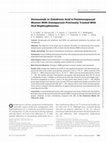
The Journal of Clinical Endocrinology & Metabolism, 2016
Context: Denosumab and zoledronic acid (ZOL) are parenteral treatments for patients with osteopor... more Context: Denosumab and zoledronic acid (ZOL) are parenteral treatments for patients with osteoporosis. Objective: The objective of the study was to compare the effect of transitioning from oral bisphosphonates to denosumab or ZOL on bone mineral density (BMD) and bone turnover. Design and Setting: This was an international, multicenter, randomized, double-blind trial. Participants: A total of 643 postmenopausal women with osteoporosis previously treated with oral bisphosphonates participated in the study. Interventions: Subjects were randomized 1:1 to sc denosumab 60 mg every 6 months plus iv placebo once or ZOL 5 mg iv once plus sc placebo every 6 months for 12 months. Main Outcome Measures: Changes in BMD and bone turnover markers were measured. Results: BMD change from baseline at month 12 was significantly greater with denosumab compared with ZOL at the lumbar spine (primary end point; 3.2% vs 1.1%; P Ͻ .0001), total hip (1.9% vs 0.6%; P Ͻ .0001), femoral neck (1.2% vs Ϫ0.1%; P Ͻ .0001), and one-third radius (0.6% vs 0.0%; P Ͻ .05). The median decrease from baseline was greater with denosumab than ZOL for serum C-telopeptide of type 1 collagen at all time points after day 10 and for serum procollagen type 1 N-terminal propeptide at month 1 and at all time points after month 3 (all P Ͻ .05). Median percentage changes from baseline in serum intact PTH were significantly greater at months 3 and 9 with denosumab compared with ZOL (all P Ͻ .05). Adverse events were similar between groups. Three events consistent with the definition of atypical femoral fracture were observed (two denosumab and one ZOL). Conclusions: In postmenopausal women with osteoporosis previously treated with oral bisphosphonates, denosumab was associated with greater BMD increases at all measured skeletal sites and greater inhibition of bone remodeling compared with ZOL.
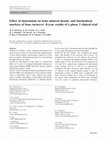
Osteoporosis International, Jul 10, 2012
In a phase 2 study, continued denosumab treatment for up to 8 years was associated with continued... more In a phase 2 study, continued denosumab treatment for up to 8 years was associated with continued gains in bone mineral density and persistent reductions in bone turnover markers. Denosumab treatment was well tolerated throughout the 8-year study. Introduction The purpose of this study is to present the effects of 8 years of continued denosumab treatment on bone mineral density (BMD) and bone turnover markers (BTM) from a phase 2 study. Methods In the 4-year parent study, postmenopausal women with low BMD were randomized to receive placebo, alendronate, or denosumab. After 2 years, subjects were reallocated to continue, discontinue, or discontinue and reinitiate denosumab; discontinue alendronate; or maintain placebo for two more years. The parent study was then extended for 4 years where all subjects received denosumab. Results Of the 262 subjects who completed the parent study, 200 enrolled in the extension, and of these, 138 completed the extension. For the subjects who received 8 years of continued denosumab treatment, BMD at the lumbar spine (N088) and total hip (N087) increased by 16.5 and 6.8 %, respectively, compared with their parent study baseline, and by 5.7 and 1.8 %, respectively, compared with their extension study baseline. For the 12 subjects in the original placebo group, 4 years of denosumab resulted in BMD gains comparable with those observed during the 4 years of denosumab in the parent study. Reductions in BTM were sustained over the course of continued denosumab treatment.
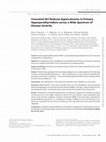
The Journal of Clinical Endocrinology and Metabolism, 2011
Context: Primary hyperparathyroidism (PHPT) is characterized by elevated serum calcium (Ca) and i... more Context: Primary hyperparathyroidism (PHPT) is characterized by elevated serum calcium (Ca) and increased PTH concentrations. Objective: The objective of the investigation was to establish the efficacy of cinacalcet in reducing serum Ca in patients with PHPT across a wide spectrum of disease severity. Design and Setting: The study was a pooled analysis of data from three multicenter clinical trials of cinacalcet in PHPT. Patients : Patients were grouped into three disease categories for analysis based on the following: 1) history of failed parathyroidectomy (n ϭ 29); 2) meeting one or more criteria for parathyroidectomy but without prior surgery (n ϭ 37); and 3) mild asymptomatic PHPT without meeting criteria for either above category (n ϭ 15). Intervention: The intervention in this study was treatment with cinacalcet for up to 4.5 yr. Outcomes: Measurements in the study included serum Ca, PTH, phosphate, and bone-specific alkaline phosphatase, and areal bone mineral density (aBMD). Vital signs, safety biochemical and hematological indices, and adverse events were monitored throughout the study period. Results: The extent of cinacalcet-induced serum Ca reduction, proportion of patients achieving normal serum Ca (Յ10.3 mg/dl), reduction in serum PTH, and increase in serum phosphate were similar across all three categories. Except for decreased aBMD at the total femur indicated for parathyroidectomy group at 1 yr, no significant changes in aBMD occurred. The efficacy of cinacalcet was maintained for up to 4.5 yr of follow-up. AEs were mild and similar across the three categories. Conclusions: Cinacalcet is equally effective in the medical management of PHPT patients across a broad spectrum of disease severity, and overall cinacalcet is well tolerated.
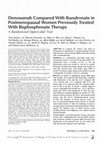
Obstetrics & Gynecology, Jun 1, 2013
To compare the efficacy and safety of denosumab to ibandronate in postmenopausal women with low b... more To compare the efficacy and safety of denosumab to ibandronate in postmenopausal women with low bone mineral density (BMD) previously treated with a bisphosphonate. METHODS: In a randomized, open-label study, postmenopausal women received 60 mg denosumab subcutaneously every 6 months (n5417) or 150 mg ibandronate orally every month (n5416) for 12 months. End points included percentage change from baseline in total hip, femoral neck, and lumbar spine BMD at month 12 and percentage change from baseline in serum C-telopeptide at months 1 and 6 in a substudy. RESULTS: At month 12, significantly greater BMD gains from baseline were observed with denosumab compared with ibandronate at the total hip (2.3% compared with 1.1%), femoral neck (1.7% compared with 0.7%), and lumbar spine (4.1% compared with 2.0%; treatment difference P,.001 at all sites). At month 1, median change in serum C-telopeptide from baseline was 281.1% with denosumab and-35.0% with ibandronate (P,.001); the treatment difference remained significant at month 6 (P,.001). Adverse events occurred in 245 (59.6%) denosumab-treated women and 230 (56.1%) ibandronate-treated women (P5.635). The incidence of serious adverse events was 9.5% for denosumab-treated women and 5.4% for ibandronate-treated women (P5.046). No clustering of events in any organ system accounted for the preponderance of these reports. The incidence rates of serious adverse events involving infection and malignancy were similar between treatment groups.
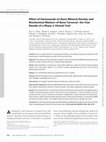
The Journal of Clinical Endocrinology and Metabolism, Feb 1, 2011
Context: This is a study extension to evaluate the efficacy and safety of long-term treatment wit... more Context: This is a study extension to evaluate the efficacy and safety of long-term treatment with denosumab in postmenopausal women with low bone mass. Objective: Our objective was to describe changes in bone mineral density (BMD) and bone turnover markers as well as safety with 6 yr of denosumab treatment. Design: We conducted an ongoing 4-yr, open-label, single-arm, extension study of a dose-ranging phase 2 trial. This paper reports a 2-yr interim analysis representing up to 6 yr of continuous denosumab treatment. Setting: This multicenter study was conducted at 23 U.S. centers. Patients: Of the 262 subjects who completed the parent study, 200 enrolled in the study extension and 178 (89%) completed the first 2 yr. Intervention: All subjects received denosumab 60 mg sc every 6 months. Main Outcome Measures: We evaluated BMD at the lumbar spine, total hip, femoral neck, and one third radius; biochemical markers of bone turnover; and safety, reported as adverse events. Results: Over a period of 6 yr, continuous treatment with denosumab resulted in progressive gains in BMD in postmenopausal women with low bone mass. Reduction in bone resorption was sustained over the course of continuous treatment. Independent of past treatment and discontinuation period, subjects demonstrated responsiveness to denosumab therapy as measured by BMD and bone turnover markers. The safety profile of denosumab did not change over time. Conclusions: In this study, denosumab was well tolerated and effective through 6 yr of continuous treatment in postmenopausal women with low bone mass.
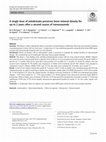
Osteoporosis International, Jul 4, 2020
This phase 2 study evaluated the efficacy and safety of transitioning to zoledronate following ro... more This phase 2 study evaluated the efficacy and safety of transitioning to zoledronate following romosozumab treatment in postmenopausal women with low bone mass. A single dose of 5 mg zoledronate generally maintained the robust BMD gains accrued with romosozumab treatment and was well tolerated. Introduction Follow-on therapy with an antiresorptive agent is necessary to maintain the skeletal benefits of romosozumab therapy. We evaluated the use of zoledronate following romosozumab treatment. Methods This phase 2, dose-finding study enrolled postmenopausal women with low bone mineral density (BMD). Subjects who received various romosozumab doses or placebo from months 0-24 were rerandomized to denosumab (60 mg SC Q6M) or placebo for 12 months, followed by open-label romosozumab (210 mg QM) for 12 months. At month 48, subjects who had received active treatment for 48 months were assigned to no further active treatment and all other subjects were assigned to zoledronate 5 mg IV. Efficacy (BMD, P1NP, and β-CTX) and safety were evaluated for 24 months, up to month 72. Results A total of 141 subjects entered the month 48-72 period, with 51 in the no further active treatment group and 90 in the zoledronate group. In subjects receiving no further active treatment, lumbar spine (LS) BMD decreased by 10.8% from months 48-72 but remained 4.2% above the original baseline. In subjects receiving zoledronate, LS BMD was maintained (percentage changes: − 0.8% from months 48-72; 12.8% from months 0-72). Similar patterns were observed for proximal femur BMD in both groups. With no further active treatment, P1NP and β-CTX decreased but remained above baseline at month 72. Following zoledronate, P1NP and β-CTX levels initially decreased but approached baseline by month 72. No new safety signals were observed. Conclusion A zoledronate follow-on regimen can maintain robust BMD gains achieved with romosozumab treatment.
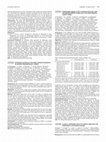
Annals of the Rheumatic Diseases, Jun 1, 2014
Saturday, 14 june 2014 769 fractures following minor trauma in 90 patients were verified with med... more Saturday, 14 june 2014 769 fractures following minor trauma in 90 patients were verified with medical records. The multivariate Cox regression analyses estimated that the hazard ratios of sustaining a proximal humerus fracture increased by 4.7 for not taking oral bisphosphonates (p=0.01), 2.1 for history of fracture (p<0.01), 2.0 for high serum C-reactive protein levels (mg/100 mL; p<0.05), 1.4 for every 10 years of increased age (p<0.01), and 1.1 for a high daily prednisolone dose (per mg/day; p<0.01). Conclusions: Not taking oral bisphosphonates, history of fracture, high Creactive protein, advanced age, and a high daily prednisolone dose appear to be associated with the occurrence of proximal humerus fractures, which were different from risk factors for clinical vertebral, hip, and distal radius fractures in the same cohort. Intake of oral bisphosphonates and a reduction in the daily prednisolone dose together with good management of the disease and prevention of falls in RA patients of advanced age or with a history of fracture may be important in preventing proximal humerus fractures. References: [1] Ochi K, Furuya T, Ikari K, Taniguchi A, Yamanaka H, Momohara S. Sites, frequencies, and causes of self-reported fractures in 9,720 rheumatoid arthritis patients: a large prospective observational cohort study in Japan.

Annals of the Rheumatic Diseases, Jun 1, 2013
ABSTRACT Background Denosumab (DMAb) reduces bone turnover in transiliac crest bone biopsies, whi... more ABSTRACT Background Denosumab (DMAb) reduces bone turnover in transiliac crest bone biopsies, which is reversible on treatment cessation (Reid JBMR 2010; Brown JBMR 2011). Long-term DMAb treatment sustains reduction in bone turnover and low incidence of vertebral and nonvertebral fractures over 6 years (Papapoulos JBMR 2012). Objectives To evaluate the effects of DMAb on remodelling at the tissue level. Methods The FREEDOM extension study included a transiliac crest bone biopsy substudy. Results 13 cross-over (placebo/DMAb) and 28 long-term (DMAb/DMAb) subjects were in this substudy after 5 years of treatment. Demographics were comparable with those of the overall FREEDOM study extension population. Mean (SD) time from last DMAb dose to first tetracycline dose was 5.7 (0.5) months. Qualitative bone histology in all samples was unremarkable, showing normally mineralized lamellar bone. Of 5 subjects in the long-term group for whom osteoid could not be visualized, samples from 4 were intact and showed normal mineralization. Structural indices were similar between the cross-over and long-term groups. Resorption was decreased, as reflected by eroded surface, in both cross-over and long-term subjects vs placebo-treated subjects in FREEDOM (Table). Double tetracycline label was seen in trabecular and/or cortical compartments in specimens from 10/13 cross-over and 14/28 long-term subjects. In 5 cross-over and 10 long-term subjects evaluable for dynamic trabecular bone parameters, dynamic remodelling indices were low in both groups, consistent with reduced bone turnover with DMAb therapy. Conclusions DMAb treatment over 5 years results in normal bone quality with reduced bone turnover. Disclosure of Interest J. Brown Grant/research support from: Amgen, Eli Lilly, Merck, Novartis, Pfizer, Servier, Roche, Takeda, Warner Chilcott, Consultant for: Amgen, Eli Lilly, Merck, Speakers bureau: Amgen, Eli Lilly, Merck, R. Wagman Shareholder of: Amgen, Employee of: Amgen, D. Dempster: None Declared, D. Kendler Grant/research support from: Merck, Amgen, Eli Lilly, Novartis, J&amp;J, Roche, Pfizer, Consultant for: Merck, Amgen, Eli Lilly, Novartis, Warner Chilcott, Pfizer, Speakers bureau: Merck, Amgen, Eli Lilly, Novartis, Warner Chilcott, Pfizer, P. Miller: None Declared, M. Bolognese Grant/research support from: Lillly, Amgen, Merck, Consultant for: Lilly, Amgen, Warner-Chilcott, Speakers bureau: Lilly, Amgen, Warner-Chilcott, I. Valter: None Declared, J.-E. Beck Jensen Consultant for: Eli Lilly, Takeda Nycomed, Amgen, Novartis, MSD, Speakers bureau: Eli Lilly, Takeda Nycomed, Amgen, Novartis, MSD, C. Zerbini: None Declared, J. Zanchetta Consultant for: Amgen, Eli Lilly, Merck, GSK, Pfizer, Speakers bureau: Amgen, Eli Lilly, Merck, GSK, Pfizer, N. Daizadeh Shareholder of: Amgen, Employee of: Amgen, I. Reid: None Declared
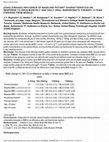
Annals of the Rheumatic Diseases, Jun 1, 2006
Background: Worldwide, substantial proportions of women suffer from postmenopausal osteoporosis a... more Background: Worldwide, substantial proportions of women suffer from postmenopausal osteoporosis and would benefit from bisphosphonate treatment. However, variations in patient characteristics may affect therapeutic responses. The MOBILE study demonstrated the comparable efficacy of once-monthly (50+50mg, 100mg or 150mg) and daily (2.5mg; 3-year vertebral fracture risk reduction: 62% 1) oral ibandronate in 1,609 women (aged 55-80 years and ≥5 years since menopause) with osteoporosis (lumbar spine bone mineral density [BMD] T-score <-2.5 and ≥-5). 2,3 A pre-specified analysis explored the influence of baseline patient characteristics on the relative efficacy of once-monthly and daily oral ibandronate for improving lumbar spine BMD over the 2-year treatment period. Methods: The influence of the following baseline patient variables on treatment outcomes was assessed: BMD, fracture history and age (Table). All analyses involved at least 20% of the overall study population. Increases in lumbar spine BMD (L2-L4) were compared across groups by a post-hoc non-inferiority test (using the pre-defined overall non-inferiority margin of 1.3%). Results: Sizeable gains in lumbar spine BMD were observed in all treatment arms and all patient subgroups (Table). In all analyses, increases in the 100mg and 150mg monthly arms were numerically greater than in the daily arm (Table). In all but a single monthly subgroup (50+50mg and aged >70 years; Table), non-inferiority to the daily group was indicated based on a lower limit of the 95% confidence interval (CI) for the difference in mean lumbar spine BMD change ≥-1.3%. Mean change (%, 95% CI for difference vs daily) in lumbar spine BMD at 2 years.
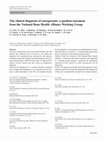
Osteoporosis International, Feb 28, 2014
Osteoporosis causes an elevated fracture risk. We propose the continued use of T-scores as one me... more Osteoporosis causes an elevated fracture risk. We propose the continued use of T-scores as one means for diagnosis but recommend that, alternatively, hip fracture; osteopenia-associated vertebral, proximal humerus, pelvis, or some wrist fractures; or FRAX scores with ≥3 % (hip) or 20 % (major) 10-year fracture risk also confer an osteoporosis diagnosis. Introduction Osteoporosis is a common disorder of reduced bone strength that predisposes to an increased risk for fractures in older individuals. In the USA, the standard criterion for the diagnosis of osteoporosis in postmenopausal women and older men is a T-score of≤−2.5 at the lumbar spine, femur neck, or total hip by bone mineral density testing. Methods Under the direction of the National Bone Health Alliance, 17 clinicians and clinical scientists were appointed to a working group charged to determine the appropriate expansion of the criteria by which osteoporosis can be diagnosed. Results The group recommends that postmenopausal women and men aged 50 years should be diagnosed with osteoporosis if they have a demonstrable elevated risk for future fractures.











Uploads
Papers by Michael Bolognese